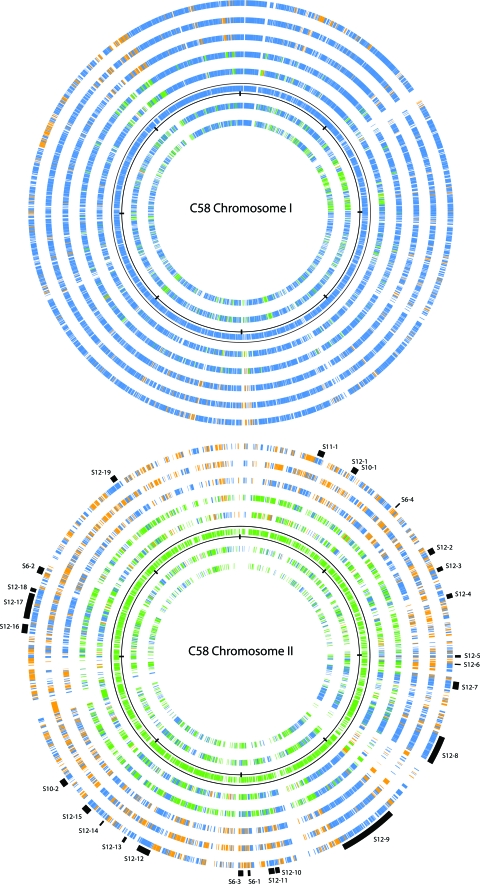FIG. 3.
Gene conservation among replicons of the Rhizobiales. Graphic depicts ortholog gene alignments shown from the outer circle and moving inward as follows (GenBank accession numbers are in parentheses): Sinorhizobium meliloti 1021 (NC_003047.1), Rhizobium leguminosarum biovar viciae 3841 (NC_008380.1), Rhizobium etli CFN42 (NC_007761.1), K84, S4, C58, Ochrobactrum anthropi ATCC 49188 (NC_009668.1), and Brucella suis 1330 (NC_004310.3). Top, the alignment is anchored by C58 chromosome I; bottom, the alignment is anchored by C58 chromosome II. The anchor replicons themselves are represented by the circles bordered by scales with marks every one-eighth of their total size. Each gene is colored according to its replicon of origin: blue for the primary chromosome, green for secondary chromosomes (including the K84 2.65-Mbp replicon), and orange for plasmids. Note that in all circles except the anchor, the location of a gene in the figure is not tied to physical position in that genome. At higher resolution (http://agro.vbi.vt.edu/public), it is possible to see that many genes in the nonanchor circles occur consecutively in their respective replicons, thus representing syntenic blocks or clusters. The positions of clusters that occur in C58 are listed in Tables S9 and S13 to S15 in the supplemental material and are indicated in the figure by the outermost-arc sections colored black. Each such arc is labeled as Sx-y, where x is the number of the table in the supplemental material and y is the order of the cluster in the table. The alignment in the top panel is predominantly blue, suggesting the high degree of conservation among Rhizobiales primary chromosomes. The alignment in the bottom panel is a mixture of blue, green, and orange, suggesting the mosaic nature of chromosome II and hinting at the various genomic transfers hypothesized to have taken place, as explained in the text.

